|
|
ARTHROPODS:
Insects»
Spiders»
Centipedes»
Millipedes»
Sowbugs»
Harvestmen»
Mites
& Ticks»
Scorpions»
Identification
Tips»
About
the Critter Files»
Links» |
|
|
|
 |
CRAB
SPIDERS
& RUNNING CRAB
SPIDERS
Critter
Files/Spiders/Crab Spiders &
Running Crab Spiders
By Blake Newton
University of Kentucky Department of Entomology |
| |
|
| There are several
types of spiders that are commonly called "Crab Spiders."
The most commonly encountered crab spiders found in Kentucky
are in the family Thomisidae. These are often called "thomisid"
crab spiders, or simply "thomsids." Thomisids tend
to have a flat shape compared to other spiders, and their front
two pairs of legs are typically very long compared to the back two
pairs. Thomisid crab spiders hold their front legs out and
up, similar to the way a crab holds its claws. Many thomisid
crab spiders have bright, "neon" colors (yellow, green,
and orange). Others have gray and brown color patterns.
|
| |
| Running
Crab Spiders belong to the family Philodromidae. They
are sometimes called "philodromid crab spiders" and they
are distinguished from thomisid crab spiders by their 2nd pair of
legs, which are always longer than the 1st, 3rd, and 4th pair. |
| |
| All crab spiders
have eight eyes. Like all spiders, crab spiders have eight legs,
two body parts (abdomen and cephalothorax), and fang-like mouthparts
called "chelicerae." |
| |
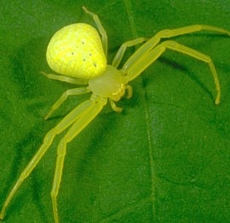
Typical thomisid crab spider. Note the
long
1st and 2nd legs. (R. Bessin, 2000) |
|
| SIZE:
Body length up to about 1/2" |
| |
| LIFE
CYCLE |
|
Like
all spiders, crab spiders go through a simple metamorphosis. Young crab spiders hatch from eggs and look like tiny adults. They
shed their skin as they grow. Many crab spiders live for less
than one year and have only one generation per year. In most
of these species, the females produce eggs in the fall, and the
offspring hatch in the spring. In other species, several generations
of females produce young each year and immature larvae are the overwintering
stage (thanks to Dr. Gary Dodson from Ball State University for
this information).
|
| ECOLOGY |
|
|
Most crab spiders and
running crab spiders do not rely on silk to capture prey. Instead,
they are ambush predators: crab spiders wait motionless on flowers,
leaves, and other strategic places for flies, bees, and similar
prey. Many crab spider species, especially in the family Thomisidae,
have the same bright colors as the flowers on which they sit. Other
crab spiders have dark colors that blend well with bark or soil.
Crab spiders are able to walk forwards, backwards, and sideways
with ease. |
| |
 Flower
spider feeding on a fly (B. Newton, 2006)
Flower
spider feeding on a fly (B. Newton, 2006)
|
| |
| PEST
STATUS |
|
Crab spiders
are considered beneficial to humans. Although they eat a few
beneficial insects (like bees), they also kill flies, mosquitoes, moths, and other insect
pests. Some species are large enough to bite people, but no
crab spiders are known to be of medical significance. |
| |
| COMMON
KENTUCKY CRAB SPIDERS |
|
|
FLOWER
SPIDERS
FAMILY: Thomisidae
| GENERA: Misumenops, Misumenoides, Misumena, others
Flower Spiders
may be the most commonly encountered crab spiders in Kentucky. Flower
spiders have bright colors which allow them to blend in with the
flowers on which they wait for prey. Some flower spiders are
able to change color to become camouflaged on different kinds of
flowers, although the color change may take a few days. Pictured
below is a flower spider from the Misumenops genus and
three views of Misumenoides formosipes. These and
related crab spiders are commonly found on Kentucky wildflowers
and flowering plants (like milkweed and Queen Anne's Lace). Thanks
to Dr. Gary Dodson from Ball State University for help with flower
spider identifications, along with biological information about
these genera. |
| |
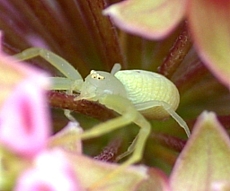 Flower spider, Misumenops sp., hunting on milkweed
Flower spider, Misumenops sp., hunting on milkweed
(B. Newton, 2003)
|
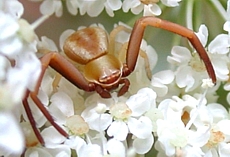 Misumenoides
formosipes on Queen Anne's Lace
Misumenoides
formosipes on Queen Anne's Lace
(B. Newton, 2003)
|
| |
|
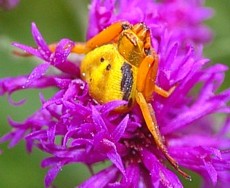 Misumenoides
formosipes on Ironweed
Misumenoides
formosipes on Ironweed
(B. Newton, 2005)
|
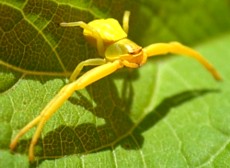 Misumenoides
formosipes waiting for prey
Misumenoides
formosipes waiting for prey
(B. Newton, 2003)
|
| |
|
|
|
|
Xysticus
and Coriarachne spp.
FAMILY: Thomisidae
| GENUS: Xysticus and Coriarchne
Crab spiders in the Xysticus
and Coriarachne
genera, like the ones pictured below, resemble flower spiders except
that they often have more subdued colors (like brown, black, and
gray). This might be because crab spiders in these genera
often hunt on the ground or on bark (instead of in flowers) where
dark colors are best for camouflage.
|
| |
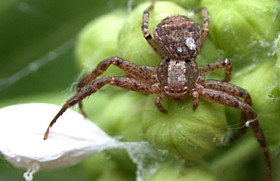 A
crab spider in the Xysticus genus, guarding an eggsac (B.
Newton, 2003)
A
crab spider in the Xysticus genus, guarding an eggsac (B.
Newton, 2003) |
|
| |
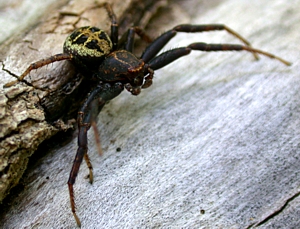 Crab
spider, Coriarachne genus (B. Newton, 2005)
Crab
spider, Coriarachne genus (B. Newton, 2005)
|
|
|
|
Tmarus
spp.
FAMILY: Thomisidae
| GENUS: Tmarus
Crab spiders in the genus
Tmarus are infrequently encountered in
Kentucky and they don't look very much like the other crab spiders
in Thomisidae. Little is known about their biology. The
ones pictured below were less than 1/2" long.
|
| |
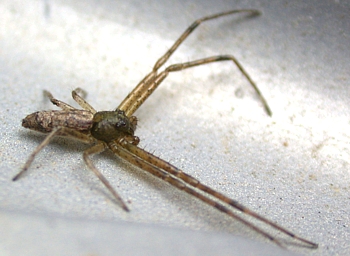 Tmarus
sp. (B. Newton, 2004)
Tmarus
sp. (B. Newton, 2004) |
|
|
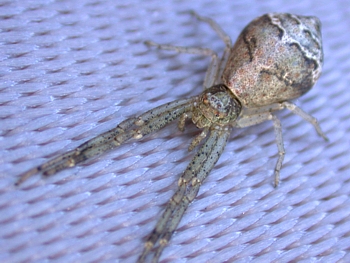 Tmarus
sp. (B. Newton, 2005)
Tmarus
sp. (B. Newton, 2005) |
|
|
|
RUNNING
CRAB SPIDERS
FAMILY: Philodromidae
Running Crab Spiders
belong to the family Philodromidae. They are not encountered
as often as crab spiders in the family Thomisidae, but they are
common nevertheless. Pictured below are running crab spiders
from the genus Tibellus and Philodromus.
|
| |
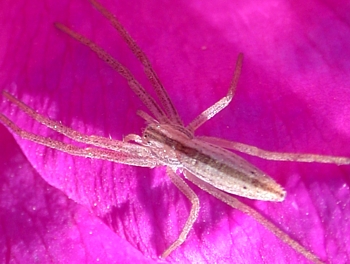 Running
Crab Spider, Tibellus sp. (B. Newton, 2004)
Running
Crab Spider, Tibellus sp. (B. Newton, 2004) |
| |
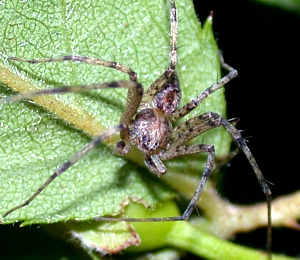 Running
Crab Spider, Philodromus sp. (B. Newton, 2005)
Running
Crab Spider, Philodromus sp. (B. Newton, 2005) |
|
| |
| COLLECTING
& PHOTOGRAPHY |
|
Although crab spiders
are fairly common, finding one might take some patience because
they are often well camouflaged, especially the ones that live on
the ground. Crab spiders make great photography subjects,
especially the brightly colored flower spiders. Flower spiders
are very common in garden flowers and in wildflowers. If you
want to find a flower spider, try to think like a flower spider:
where would you sit if you wanted flies and bees to come to you?
|
| |
| CRAB
SPIDER FACTS |
|
Scientists think that
the venom of certain crab spiders is more potent than that of most
other spiders: this allows crab spiders to quickly paralyze the
large and tough bees that often visit flowers. However, crab
spider venom is not known to be especially dangerous to humans.
The University of Nebraska
Entomology website has some great pictures of crab spiders at: http://entomology.unl.edu/images/spiders/spiders3.htm
|
| |
| MYTHS
- LEGENDS - FOLKLORE |
|
Do you know any myths,
legends, or folklore about crab spiders? If so, let us know.
|
| |
Original document: 25 May 2004
Last updated: 12 Jan 2007
Photos courtesy R.
Bessin and B. Newton, University of Kentucky
The Kentucky Critter Files are maintained by Blake Newton, Department
of Entomology, University of Kentucky.
Contact: blaken@uky.edu
|
|

